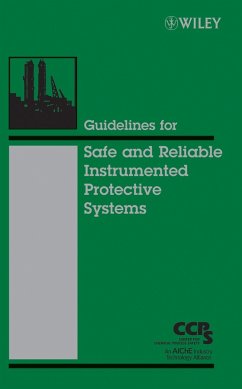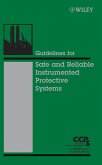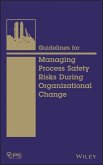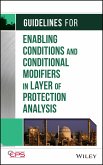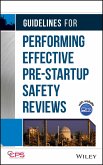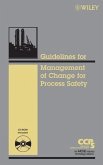Ccps (Center For Chemical Process Safety)
Guidelines for Safe and Reliable Instrumented Protective Systems (eBook, ePUB)
171,99 €
171,99 €
inkl. MwSt.
Sofort per Download lieferbar

0 °P sammeln
171,99 €
Als Download kaufen

171,99 €
inkl. MwSt.
Sofort per Download lieferbar

0 °P sammeln
Jetzt verschenken
Alle Infos zum eBook verschenken
171,99 €
inkl. MwSt.
Sofort per Download lieferbar
Alle Infos zum eBook verschenken

0 °P sammeln
Ccps (Center For Chemical Process Safety)
Guidelines for Safe and Reliable Instrumented Protective Systems (eBook, ePUB)
- Format: ePub
- Merkliste
- Auf die Merkliste
- Bewerten Bewerten
- Teilen
- Produkt teilen
- Produkterinnerung
- Produkterinnerung

Bitte loggen Sie sich zunächst in Ihr Kundenkonto ein oder registrieren Sie sich bei
bücher.de, um das eBook-Abo tolino select nutzen zu können.
Hier können Sie sich einloggen
Hier können Sie sich einloggen
Sie sind bereits eingeloggt. Klicken Sie auf 2. tolino select Abo, um fortzufahren.

Bitte loggen Sie sich zunächst in Ihr Kundenkonto ein oder registrieren Sie sich bei bücher.de, um das eBook-Abo tolino select nutzen zu können.
This book explains the decision-making processes for the management of instrumented protective systems (IPS) throughout a project's life cycle. It uses the new IEC 61511 standard as a basis for the work processes used to achieve safe and reliable process operation. By walking the reader through a project's life cycle, engineering, maintenance, and operations, the information allows users to easily focus on their responsibilities and duties. Using this approach, the book is useful as a primer, guidelines reference, and resource manual. Examples provide the added "e;real-world"e; experience applications.…mehr
- Geräte: eReader
- mit Kopierschutz
- eBook Hilfe
- Größe: 4.3MB
Andere Kunden interessierten sich auch für
![Guidelines for Safe and Reliable Instrumented Protective Systems (eBook, PDF) Guidelines for Safe and Reliable Instrumented Protective Systems (eBook, PDF)]() Ccps (Center For Chemical Process Safety)Guidelines for Safe and Reliable Instrumented Protective Systems (eBook, PDF)171,99 €
Ccps (Center For Chemical Process Safety)Guidelines for Safe and Reliable Instrumented Protective Systems (eBook, PDF)171,99 €![Guidelines for Managing Process Safety Risks During Organizational Change (eBook, ePUB) Guidelines for Managing Process Safety Risks During Organizational Change (eBook, ePUB)]() Ccps (Center For Chemical Process Safety)Guidelines for Managing Process Safety Risks During Organizational Change (eBook, ePUB)101,99 €
Ccps (Center For Chemical Process Safety)Guidelines for Managing Process Safety Risks During Organizational Change (eBook, ePUB)101,99 €![Guidelines for Process Safety Acquisition Evaluation and Post Merger Integration (eBook, ePUB) Guidelines for Process Safety Acquisition Evaluation and Post Merger Integration (eBook, ePUB)]() Ccps (Center For Chemical Process Safety)Guidelines for Process Safety Acquisition Evaluation and Post Merger Integration (eBook, ePUB)107,99 €
Ccps (Center For Chemical Process Safety)Guidelines for Process Safety Acquisition Evaluation and Post Merger Integration (eBook, ePUB)107,99 €![Guidelines for Defining Process Safety Competency Requirements (eBook, ePUB) Guidelines for Defining Process Safety Competency Requirements (eBook, ePUB)]() Ccps (Center For Chemical Process Safety)Guidelines for Defining Process Safety Competency Requirements (eBook, ePUB)79,99 €
Ccps (Center For Chemical Process Safety)Guidelines for Defining Process Safety Competency Requirements (eBook, ePUB)79,99 €![Guidelines for Enabling Conditions and Conditional Modifiers in Layer of Protection Analysis (eBook, ePUB) Guidelines for Enabling Conditions and Conditional Modifiers in Layer of Protection Analysis (eBook, ePUB)]() Ccps (Center For Chemical Process Safety)Guidelines for Enabling Conditions and Conditional Modifiers in Layer of Protection Analysis (eBook, ePUB)88,99 €
Ccps (Center For Chemical Process Safety)Guidelines for Enabling Conditions and Conditional Modifiers in Layer of Protection Analysis (eBook, ePUB)88,99 €![Guidelines for Performing Effective Pre-Startup Safety Reviews (eBook, ePUB) Guidelines for Performing Effective Pre-Startup Safety Reviews (eBook, ePUB)]() Ccps (Center For Chemical Process Safety)Guidelines for Performing Effective Pre-Startup Safety Reviews (eBook, ePUB)151,99 €
Ccps (Center For Chemical Process Safety)Guidelines for Performing Effective Pre-Startup Safety Reviews (eBook, ePUB)151,99 €![Guidelines for the Management of Change for Process Safety (eBook, ePUB) Guidelines for the Management of Change for Process Safety (eBook, ePUB)]() Ccps (Center For Chemical Process Safety)Guidelines for the Management of Change for Process Safety (eBook, ePUB)116,99 €
Ccps (Center For Chemical Process Safety)Guidelines for the Management of Change for Process Safety (eBook, ePUB)116,99 €-
-
-
This book explains the decision-making processes for the management of instrumented protective systems (IPS) throughout a project's life cycle. It uses the new IEC 61511 standard as a basis for the work processes used to achieve safe and reliable process operation. By walking the reader through a project's life cycle, engineering, maintenance, and operations, the information allows users to easily focus on their responsibilities and duties. Using this approach, the book is useful as a primer, guidelines reference, and resource manual. Examples provide the added "e;real-world"e; experience applications.
Dieser Download kann aus rechtlichen Gründen nur mit Rechnungsadresse in D ausgeliefert werden.
Produktdetails
- Produktdetails
- Verlag: John Wiley & Sons
- Erscheinungstermin: 16. November 2011
- Englisch
- ISBN-13: 9781118209691
- Artikelnr.: 37486491
- Verlag: John Wiley & Sons
- Erscheinungstermin: 16. November 2011
- Englisch
- ISBN-13: 9781118209691
- Artikelnr.: 37486491
- Herstellerkennzeichnung Die Herstellerinformationen sind derzeit nicht verfügbar.
Since 1985, the Center for Chemical Process Safety (CCPS) has been the world leader in developing and disseminating information on process safety management and technology. CCPS, an industry technology alliance of the American Institute of Chemical Engineers (AIChE), has published over 80 books in its process safety guidelines and process safety concepts series.
Acknowledgements.
Preface.
List of Figures.
List of Tables.
INTRODUCTION.
1.1 Purpose.
1.2 Target Audience.
Book Road Map.
1.4 Management Commitment.
PLANNING.
2.1 Protective Management System Lifecycle.
2.2 Why It Makes Good Business Sense.
2.3 Documentation.
2.4 Good Engineering Practices.
2.5 Key Management System Elements.
2.6 Special Topics.
RISK ASSESSMENT.
3.1 Intended Audience.
3.2 Input Information.
3.3 Basic Work Process.
3.4 Output Documentation.
3.5 Key Management System Elements.
3.6 Special Topics.
DESIGN.
4.1 Intended Audience.
4.2 Input Information.
4.3 Basic Work Process.
4.4 Output Documentation.
4.5 Process Requirements.
4.6 I&E Requirements.
4.7 Functional Assessment.
4.8 Key Management System Elements.
4.9 Special Topics.
ENGINEERING, INSTALLATION, COMMISSIONING AND VALIDATION.
5.1 Intended Audience.
5.2 Input Information.
5.3 Basic Work Projects.
5.4 Output Documentation.
5.5 Hardware.
5.6 Software.
5.7 Factory Acceptance Test.
5.8 Installation Plans.
5.9 Commissioning Plans.
5.10 Verify Operator and External Interfaces.
5.11 Validation.
5.12 Management of Change.
OPERATIONAL AND MECHANICAL INTEGRITY.
6.1 Intended Audience.
6.2 Input Information.
6.3 Basic Work Process.
6.4 Output Documentation.
6.5 Operating Procedures.
6.6 Bypass management Procedure.
6.7 Maintenance Procedures.
6.8 Training.
6.9 Managing Changes.
6.10 Monitoring performance.
CONTINOUS IMPROVEMENT.
7.1 Intended Audience.
7.2 Input Information.
7.3 Basic Work Process.
7.4 Output Documentation.
7.5 Determining Path Forward.
DEFINITIONS.
PROTECTION LAYERS.
B.1 Inherently Safer Design.
B.2 Control.
B.3 Supervisory.
B.4 Preventive.
B.5 Mitigative.
B.6 Barriers.
B.7 Limitation.
B.8 Response.
CORE ATTRIBUTES.
C.1 Independence.
C.2 Functionality.
C.3 Integrity.
C.4 Reliability.
C.5 Auditability.
C.6 Access Security.
C.7 Management of Change.
UNDERSTANDING FAILURE.
D.1 Caution-It's A Benchmark.
D.2 A "Bathtub"; Viewpoint.
D.3 Failure Types.
D.4 Failure Classification.
D.5 IPF Performance metrics.
D.6 Spurious Trip Rate.
D.7 Example Application.
PROCESS EQUIPMENT RELIABILITY DATABASE.
USER APPROVED EQUIPMENT AND PRACTICES.
F.1 User Approved.
F.2 Evolution of Plant Automation.
F.3 Logic Solver Considerations.
F.4 Field Device Considerations.
F.5 Utilities.
F.6 Wiring Practices.
F.7 Communications and Interconnectivity.
F.8 Prescriptive Design.
References.
Acronyms and Abbreviations.
Index.
Preface.
List of Figures.
List of Tables.
INTRODUCTION.
1.1 Purpose.
1.2 Target Audience.
Book Road Map.
1.4 Management Commitment.
PLANNING.
2.1 Protective Management System Lifecycle.
2.2 Why It Makes Good Business Sense.
2.3 Documentation.
2.4 Good Engineering Practices.
2.5 Key Management System Elements.
2.6 Special Topics.
RISK ASSESSMENT.
3.1 Intended Audience.
3.2 Input Information.
3.3 Basic Work Process.
3.4 Output Documentation.
3.5 Key Management System Elements.
3.6 Special Topics.
DESIGN.
4.1 Intended Audience.
4.2 Input Information.
4.3 Basic Work Process.
4.4 Output Documentation.
4.5 Process Requirements.
4.6 I&E Requirements.
4.7 Functional Assessment.
4.8 Key Management System Elements.
4.9 Special Topics.
ENGINEERING, INSTALLATION, COMMISSIONING AND VALIDATION.
5.1 Intended Audience.
5.2 Input Information.
5.3 Basic Work Projects.
5.4 Output Documentation.
5.5 Hardware.
5.6 Software.
5.7 Factory Acceptance Test.
5.8 Installation Plans.
5.9 Commissioning Plans.
5.10 Verify Operator and External Interfaces.
5.11 Validation.
5.12 Management of Change.
OPERATIONAL AND MECHANICAL INTEGRITY.
6.1 Intended Audience.
6.2 Input Information.
6.3 Basic Work Process.
6.4 Output Documentation.
6.5 Operating Procedures.
6.6 Bypass management Procedure.
6.7 Maintenance Procedures.
6.8 Training.
6.9 Managing Changes.
6.10 Monitoring performance.
CONTINOUS IMPROVEMENT.
7.1 Intended Audience.
7.2 Input Information.
7.3 Basic Work Process.
7.4 Output Documentation.
7.5 Determining Path Forward.
DEFINITIONS.
PROTECTION LAYERS.
B.1 Inherently Safer Design.
B.2 Control.
B.3 Supervisory.
B.4 Preventive.
B.5 Mitigative.
B.6 Barriers.
B.7 Limitation.
B.8 Response.
CORE ATTRIBUTES.
C.1 Independence.
C.2 Functionality.
C.3 Integrity.
C.4 Reliability.
C.5 Auditability.
C.6 Access Security.
C.7 Management of Change.
UNDERSTANDING FAILURE.
D.1 Caution-It's A Benchmark.
D.2 A "Bathtub"; Viewpoint.
D.3 Failure Types.
D.4 Failure Classification.
D.5 IPF Performance metrics.
D.6 Spurious Trip Rate.
D.7 Example Application.
PROCESS EQUIPMENT RELIABILITY DATABASE.
USER APPROVED EQUIPMENT AND PRACTICES.
F.1 User Approved.
F.2 Evolution of Plant Automation.
F.3 Logic Solver Considerations.
F.4 Field Device Considerations.
F.5 Utilities.
F.6 Wiring Practices.
F.7 Communications and Interconnectivity.
F.8 Prescriptive Design.
References.
Acronyms and Abbreviations.
Index.
Acknowledgements.
Preface.
List of Figures.
List of Tables.
INTRODUCTION.
1.1 Purpose.
1.2 Target Audience.
Book Road Map.
1.4 Management Commitment.
PLANNING.
2.1 Protective Management System Lifecycle.
2.2 Why It Makes Good Business Sense.
2.3 Documentation.
2.4 Good Engineering Practices.
2.5 Key Management System Elements.
2.6 Special Topics.
RISK ASSESSMENT.
3.1 Intended Audience.
3.2 Input Information.
3.3 Basic Work Process.
3.4 Output Documentation.
3.5 Key Management System Elements.
3.6 Special Topics.
DESIGN.
4.1 Intended Audience.
4.2 Input Information.
4.3 Basic Work Process.
4.4 Output Documentation.
4.5 Process Requirements.
4.6 I&E Requirements.
4.7 Functional Assessment.
4.8 Key Management System Elements.
4.9 Special Topics.
ENGINEERING, INSTALLATION, COMMISSIONING AND VALIDATION.
5.1 Intended Audience.
5.2 Input Information.
5.3 Basic Work Projects.
5.4 Output Documentation.
5.5 Hardware.
5.6 Software.
5.7 Factory Acceptance Test.
5.8 Installation Plans.
5.9 Commissioning Plans.
5.10 Verify Operator and External Interfaces.
5.11 Validation.
5.12 Management of Change.
OPERATIONAL AND MECHANICAL INTEGRITY.
6.1 Intended Audience.
6.2 Input Information.
6.3 Basic Work Process.
6.4 Output Documentation.
6.5 Operating Procedures.
6.6 Bypass management Procedure.
6.7 Maintenance Procedures.
6.8 Training.
6.9 Managing Changes.
6.10 Monitoring performance.
CONTINOUS IMPROVEMENT.
7.1 Intended Audience.
7.2 Input Information.
7.3 Basic Work Process.
7.4 Output Documentation.
7.5 Determining Path Forward.
DEFINITIONS.
PROTECTION LAYERS.
B.1 Inherently Safer Design.
B.2 Control.
B.3 Supervisory.
B.4 Preventive.
B.5 Mitigative.
B.6 Barriers.
B.7 Limitation.
B.8 Response.
CORE ATTRIBUTES.
C.1 Independence.
C.2 Functionality.
C.3 Integrity.
C.4 Reliability.
C.5 Auditability.
C.6 Access Security.
C.7 Management of Change.
UNDERSTANDING FAILURE.
D.1 Caution-It's A Benchmark.
D.2 A "Bathtub"; Viewpoint.
D.3 Failure Types.
D.4 Failure Classification.
D.5 IPF Performance metrics.
D.6 Spurious Trip Rate.
D.7 Example Application.
PROCESS EQUIPMENT RELIABILITY DATABASE.
USER APPROVED EQUIPMENT AND PRACTICES.
F.1 User Approved.
F.2 Evolution of Plant Automation.
F.3 Logic Solver Considerations.
F.4 Field Device Considerations.
F.5 Utilities.
F.6 Wiring Practices.
F.7 Communications and Interconnectivity.
F.8 Prescriptive Design.
References.
Acronyms and Abbreviations.
Index.
Preface.
List of Figures.
List of Tables.
INTRODUCTION.
1.1 Purpose.
1.2 Target Audience.
Book Road Map.
1.4 Management Commitment.
PLANNING.
2.1 Protective Management System Lifecycle.
2.2 Why It Makes Good Business Sense.
2.3 Documentation.
2.4 Good Engineering Practices.
2.5 Key Management System Elements.
2.6 Special Topics.
RISK ASSESSMENT.
3.1 Intended Audience.
3.2 Input Information.
3.3 Basic Work Process.
3.4 Output Documentation.
3.5 Key Management System Elements.
3.6 Special Topics.
DESIGN.
4.1 Intended Audience.
4.2 Input Information.
4.3 Basic Work Process.
4.4 Output Documentation.
4.5 Process Requirements.
4.6 I&E Requirements.
4.7 Functional Assessment.
4.8 Key Management System Elements.
4.9 Special Topics.
ENGINEERING, INSTALLATION, COMMISSIONING AND VALIDATION.
5.1 Intended Audience.
5.2 Input Information.
5.3 Basic Work Projects.
5.4 Output Documentation.
5.5 Hardware.
5.6 Software.
5.7 Factory Acceptance Test.
5.8 Installation Plans.
5.9 Commissioning Plans.
5.10 Verify Operator and External Interfaces.
5.11 Validation.
5.12 Management of Change.
OPERATIONAL AND MECHANICAL INTEGRITY.
6.1 Intended Audience.
6.2 Input Information.
6.3 Basic Work Process.
6.4 Output Documentation.
6.5 Operating Procedures.
6.6 Bypass management Procedure.
6.7 Maintenance Procedures.
6.8 Training.
6.9 Managing Changes.
6.10 Monitoring performance.
CONTINOUS IMPROVEMENT.
7.1 Intended Audience.
7.2 Input Information.
7.3 Basic Work Process.
7.4 Output Documentation.
7.5 Determining Path Forward.
DEFINITIONS.
PROTECTION LAYERS.
B.1 Inherently Safer Design.
B.2 Control.
B.3 Supervisory.
B.4 Preventive.
B.5 Mitigative.
B.6 Barriers.
B.7 Limitation.
B.8 Response.
CORE ATTRIBUTES.
C.1 Independence.
C.2 Functionality.
C.3 Integrity.
C.4 Reliability.
C.5 Auditability.
C.6 Access Security.
C.7 Management of Change.
UNDERSTANDING FAILURE.
D.1 Caution-It's A Benchmark.
D.2 A "Bathtub"; Viewpoint.
D.3 Failure Types.
D.4 Failure Classification.
D.5 IPF Performance metrics.
D.6 Spurious Trip Rate.
D.7 Example Application.
PROCESS EQUIPMENT RELIABILITY DATABASE.
USER APPROVED EQUIPMENT AND PRACTICES.
F.1 User Approved.
F.2 Evolution of Plant Automation.
F.3 Logic Solver Considerations.
F.4 Field Device Considerations.
F.5 Utilities.
F.6 Wiring Practices.
F.7 Communications and Interconnectivity.
F.8 Prescriptive Design.
References.
Acronyms and Abbreviations.
Index.
